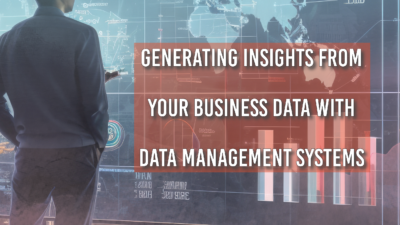Generating Insights from Your Business Data with Data Management Systems
Generating Insights from Your Business Data with Data Management Systems
Author: GDS
In the era of digital transformation, businesses are inundated with data from diverse sources. Managing such a vast amount of data and utilizing it effectively is pivotal for informed decision-making. This blog post focuses on the importance of data management systems in organizations. It delves into how these systems help in gathering, organizing, securing, and storing data from disparate systems into a single, trusted source of information. Drawing insights from this consolidated data significantly contributes to the understanding of key business aspects such as customer preferences, inventory management, and sales efficiency. Join us as we explore the role of data management in generating actionable insights from your business data.
In the era of digital transformation, businesses are inundated with data from diverse sources. Managing such a vast amount of data and utilizing it effectively is pivotal for informed decision-making. This blog post focuses on the importance of data management systems in organizations. It delves into how these systems help in gathering, organizing, securing, and storing data from disparate systems into a single, trusted source of information. Drawing insights from this consolidated data significantly contributes to the understanding of key business aspects such as customer preferences, inventory management, and sales efficiency. Join us as we explore the role of data management in generating actionable insights from your business data.
What is Data Management?
Data management is a comprehensive method of collecting, validating, storing, protecting, and processing required data to ensure the accessibility, reliability, and timeliness of the data for its users. It encompasses a variety of functions and practices such as data governance, data architecture, data quality management, and data security. These functions work together to create a system where data from different sources is stored in an organized, secure manner, providing a single, trusted source of information. This process is pivotal in businesses, as it enables them to leverage this consolidated data effectively for decision-making and gaining valuable insights.
What is Data Management?
Data management is a comprehensive method of collecting, validating, storing, protecting, and processing required data to ensure the accessibility, reliability, and timeliness of the data for its users. It encompasses a variety of functions and practices such as data governance, data architecture, data quality management, and data security. These functions work together to create a system where data from different sources is stored in an organized, secure manner, providing a single, trusted source of information. This process is pivotal in businesses, as it enables them to leverage this consolidated data effectively for decision-making and gaining valuable insights.
The Process of Gathering, Organizing, Securing, and Storing Data
The first step in data management is gathering. This involves the collection of data from various sources, which may include internal systems, external databases, or direct user input. The data collected could be structured, such as sales figures, or unstructured, such as customer feedback.
Once data is gathered, it must be organized in a way that makes it easily retrievable. This could involve categorizing data based on certain attributes, using a consistent naming convention, or creating a data map to visually represent where each piece of data is stored.
Securing the data is the next key step. This includes implementing measures to protect the data from unauthorized access or modifications. It could also involve establishing protocols for data backup and recovery to ensure the data can be restored in case of a loss.
Finally, storing data involves deciding on a suitable data storage solution based on the size and type of the data, as well as the business’s specific requirements. This could range from on-site servers to cloud storage options. Proper storage ensures that data remains accessible and usable for decision-making and insight generation.
The Process of Gathering, Organizing, Securing, and Storing Data
The first step in data management is gathering. This involves the collection of data from various sources, which may include internal systems, external databases, or direct user input. The data collected could be structured, such as sales figures, or unstructured, such as customer feedback.
Once data is gathered, it must be organized in a way that makes it easily retrievable. This could involve categorizing data based on certain attributes, using a consistent naming convention, or creating a data map to visually represent where each piece of data is stored.
Securing the data is the next key step. This includes implementing measures to protect the data from unauthorized access or modifications. It could also involve establishing protocols for data backup and recovery to ensure the data can be restored in case of a loss.
Finally, storing data involves deciding on a suitable data storage solution based on the size and type of the data, as well as the business’s specific requirements. This could range from on-site servers to cloud storage options. Proper storage ensures that data remains accessible and usable for decision-making and insight generation.
The Role of Data Management Systems in Handling Data from Disparate Sources
Data management systems play a crucial role in handling data from disparate sources. They consolidate and streamline the process of gathering and organizing varied types of data into a cohesive, usable format. Data management systems are designed to ingest data from multiple sources, whether it be structured data from internal databases or unstructured data from external inputs.
Through the use of advanced algorithms and machine learning techniques, these systems can categorize and normalize the disparate data, making it easier to analyze and interpret. They establish a single source of truth, eliminating any discrepancies or redundancies in the data.
Moreover, data management systems provide robust security measures to protect the integrity and confidentiality of the data. They employ encryption, user access controls, and regular auditing to safeguard against unauthorized access.
In terms of storage, data management systems provide flexible options that cater to the specific needs of a business. They can store large volumes of data and allow for efficient retrieval of information when needed. This ensures that data remains accessible and usable, empowering businesses to make more informed decisions and derive valuable insights.
The Role of Data Management Systems in Handling Data from Disparate Sources
Data management systems play a crucial role in handling data from disparate sources. They consolidate and streamline the process of gathering and organizing varied types of data into a cohesive, usable format. Data management systems are designed to ingest data from multiple sources, whether it be structured data from internal databases or unstructured data from external inputs.
Through the use of advanced algorithms and machine learning techniques, these systems can categorize and normalize the disparate data, making it easier to analyze and interpret. They establish a single source of truth, eliminating any discrepancies or redundancies in the data.
Moreover, data management systems provide robust security measures to protect the integrity and confidentiality of the data. They employ encryption, user access controls, and regular auditing to safeguard against unauthorized access.
In terms of storage, data management systems provide flexible options that cater to the specific needs of a business. They can store large volumes of data and allow for efficient retrieval of information when needed. This ensures that data remains accessible and usable, empowering businesses to make more informed decisions and derive valuable insights.
Benefits of an Effective Data Management System
Effective data management systems offer a plethora of benefits that can drive business growth and efficiency. Firstly, they ensure data accuracy and consistency by eliminating redundancies and discrepancies, enhancing the trustworthiness of the data. This leads to better decision-making as businesses can rely on a single source of truth.
These systems improve operational efficiency by automating manual data management tasks, freeing up valuable time that can be used for strategic planning. They also enhance data security, leveraging cutting-edge encryption methods and user-access controls to prevent unauthorized data access and breaches.
A well-managed data system enables comprehensive data analysis. With unified and standardized data, businesses can derive meaningful insights, identify trends, and make predictions, thereby gaining a competitive edge in the market.
Lastly, effective data management systems offer scalable storage solutions, accommodating the growing volume of business data. They allow for efficient data retrieval, ensuring that data remains accessible and usable for decision-making and insight generation, thus playing a pivotal role in an organization’s data strategy.
Here are the key benefits that an effective data management system provides:
- Data Accuracy and Consistency: Reduces redundancies and discrepancies in data, thereby enhancing its trustworthiness.
- Operational Efficiency: Automates manual tasks, freeing up time for strategic planning and decision-making.
- Enhanced Data Security: Uses state-of-the-art encryption and access controls to prevent unauthorized data access or breaches.
- Data Analysis: With unified and standardized data, businesses can identify trends, make predictions, and derive meaningful insights.
- Scalable Storage Solutions: Accommodates growing volumes of data, ensuring that information remains accessible and usable for decision-making.
Benefits of an Effective Data Management System
Effective data management systems offer a plethora of benefits that can drive business growth and efficiency. Firstly, they ensure data accuracy and consistency by eliminating redundancies and discrepancies, enhancing the trustworthiness of the data. This leads to better decision-making as businesses can rely on a single source of truth.
These systems improve operational efficiency by automating manual data management tasks, freeing up valuable time that can be used for strategic planning. They also enhance data security, leveraging cutting-edge encryption methods and user-access controls to prevent unauthorized data access and breaches.
A well-managed data system enables comprehensive data analysis. With unified and standardized data, businesses can derive meaningful insights, identify trends, and make predictions, thereby gaining a competitive edge in the market.
Lastly, effective data management systems offer scalable storage solutions, accommodating the growing volume of business data. They allow for efficient data retrieval, ensuring that data remains accessible and usable for decision-making and insight generation, thus playing a pivotal role in an organization’s data strategy.
Here are the key benefits that an effective data management system provides:
- Data Accuracy and Consistency: Reduces redundancies and discrepancies in data, thereby enhancing its trustworthiness.
- Operational Efficiency: Automates manual tasks, freeing up time for strategic planning and decision-making.
- Enhanced Data Security: Uses state-of-the-art encryption and access controls to prevent unauthorized data access or breaches.
- Data Analysis: With unified and standardized data, businesses can identify trends, make predictions, and derive meaningful insights.
- Scalable Storage Solutions: Accommodates growing volumes of data, ensuring that information remains accessible and usable for decision-making.
How data management contributes to understanding customer preferences, inventory management, and sales efficiency
Data management plays an instrumental role in understanding customer preferences, inventory management, and sales efficiency. By accurately compiling and analyzing customer data, businesses can discern patterns and trends in consumer behavior. This information allows them to cater to specific customer needs and preferences, thus enhancing customer satisfaction and loyalty.
Similarly, in the realm of inventory management, data management helps track inventory levels in real time, predict future demand, and mitigate the risk of overstock or stockouts. This leads to cost-effective inventory management and a smoother supply chain process.
In terms of sales efficiency, a robust data management system provides comprehensive visibility into sales performance. It enables the analysis of sales trends over time, the identification of high-performing products or services, and the evaluation of sales strategies. This valuable insight aids in optimizing sales operations and driving revenue growth.
In essence, effective data management is an invaluable tool for improving business performance across multiple areas. It unlocks the power of data, enabling businesses to make informed decisions that enhance their operational efficiency and competitive advantage.
How data management contributes to understanding customer preferences, inventory management, and sales efficiency
Data management plays an instrumental role in understanding customer preferences, inventory management, and sales efficiency. By accurately compiling and analyzing customer data, businesses can discern patterns and trends in consumer behavior. This information allows them to cater to specific customer needs and preferences, thus enhancing customer satisfaction and loyalty.
Similarly, in the realm of inventory management, data management helps track inventory levels in real time, predict future demand, and mitigate the risk of overstock or stockouts. This leads to cost-effective inventory management and a smoother supply chain process.
In terms of sales efficiency, a robust data management system provides comprehensive visibility into sales performance. It enables the analysis of sales trends over time, the identification of high-performing products or services, and the evaluation of sales strategies. This valuable insight aids in optimizing sales operations and driving revenue growth.
In essence, effective data management is an invaluable tool for improving business performance across multiple areas. It unlocks the power of data, enabling businesses to make informed decisions that enhance their operational efficiency and competitive advantage.
Case Studies: Successful Use of Data Management for Business Insights
- Amazon: Known for its customer-centric approach, Amazon uses data management to gain comprehensive insights into customer behavior. Its robust data management system collects and analyzes data on customer preferences, search history, and purchase patterns. This information is then used to personalize the shopping experience for each customer, recommend relevant products, and enhance customer engagement and loyalty.
- Walmart: Walmart’s data management system plays a critical role in its inventory management. By accurately tracking inventory levels and predicting future demand, the retail giant ensures optimal stock levels, mitigates the risk of overstock, and enhances the overall efficiency of its supply chain processes.
- Netflix: Netflix’s success can be attributed in part to its effective use of data management. The streaming service collects and analyzes vast amounts of data on viewer preferences and viewing habits. This data is then used to make informed decisions on content production and recommendation, resulting in a personalized and engaging viewer experience.
These examples underscore the immense potential of effective data management in driving business success. By harnessing the power of data, businesses can gain valuable insights, make informed decisions, and strengthen their competitive advantage.
Case Studies: Successful Use of Data Management for Business Insights
- Amazon: Known for its customer-centric approach, Amazon uses data management to gain comprehensive insights into customer behavior. Its robust data management system collects and analyzes data on customer preferences, search history, and purchase patterns. This information is then used to personalize the shopping experience for each customer, recommend relevant products, and enhance customer engagement and loyalty.
- Walmart: Walmart’s data management system plays a critical role in its inventory management. By accurately tracking inventory levels and predicting future demand, the retail giant ensures optimal stock levels, mitigates the risk of overstock, and enhances the overall efficiency of its supply chain processes.
- Netflix: Netflix’s success can be attributed in part to its effective use of data management. The streaming service collects and analyzes vast amounts of data on viewer preferences and viewing habits. This data is then used to make informed decisions on content production and recommendation, resulting in a personalized and engaging viewer experience.
These examples underscore the immense potential of effective data management in driving business success. By harnessing the power of data, businesses can gain valuable insights, make informed decisions, and strengthen their competitive advantage.
Implementing Data Management in Your Business
Implementing a data management system in your business requires careful planning, a well-defined strategy, and the right tools. Here are crucial steps you should consider:
- Assess Current Data Management Practices: Initially, it’s essential to evaluate your existing data handling processes. Understand where your data is coming from, how it’s stored, and how it’s used within your organization.
- Define Clear Objectives: Articulate what you hope to achieve by implementing a data management system. Your objectives could include improving data quality, increasing data security, or gaining better business insights.
- Choose the Right Data Management Tools: The market offers a myriad of data management solutions. Select tools that align with your business needs and objectives, considering aspects like scalability, ease of use, and integration with existing systems.
- Develop a Data Governance Framework: This framework should define roles and responsibilities, data standards, and procedures for data handling, ensuring data consistency and quality.
- Train Your Staff: Data management involves everyone in your organization. Ensure your team is fully trained on the importance of data management, the use of chosen tools, and adherence to data governance policies.
Implementing Data Management in Your Business
Implementing a data management system in your business requires careful planning, a well-defined strategy, and the right tools. Here are crucial steps you should consider:
- Assess Current Data Management Practices: Initially, it’s essential to evaluate your existing data handling processes. Understand where your data is coming from, how it’s stored, and how it’s used within your organization.
- Define Clear Objectives: Articulate what you hope to achieve by implementing a data management system. Your objectives could include improving data quality, increasing data security, or gaining better business insights.
- Choose the Right Data Management Tools: The market offers a myriad of data management solutions. Select tools that align with your business needs and objectives, considering aspects like scalability, ease of use, and integration with existing systems.
- Develop a Data Governance Framework: This framework should define roles and responsibilities, data standards, and procedures for data handling, ensuring data consistency and quality.
- Train Your Staff: Data management involves everyone in your organization. Ensure your team is fully trained on the importance of data management, the use of chosen tools, and adherence to data governance policies.
Challenges and How to Overcome Them
Like any business initiative, data management implementation can face challenges. Here are a few common ones and tips on how to overcome them:
- Resistance to Change: Employees might resist new data management practices. Overcome this by emphasizing the benefits of the new system, offering comprehensive training, and encouraging feedback.
- Data Quality Issues: Poor quality data can undermine the value of your data management system. Maintain high-quality data by implementing rigorous data validation rules and regularly auditing your data.
- Security Concerns: Data breaches can damage your business’s reputation and bottom line. Enhance data security by implementing robust security protocols, regularly updating your systems, and training your staff on data security best practices.
Remember, the goal of data management is to transform data into actionable insights. With the right system in place, your business will be better equipped to make informed decisions that drive growth and competitiveness.
Challenges and How to Overcome Them
Like any business initiative, data management implementation can face challenges. Here are a few common ones and tips on how to overcome them:
- Resistance to Change: Employees might resist new data management practices. Overcome this by emphasizing the benefits of the new system, offering comprehensive training, and encouraging feedback.
- Data Quality Issues: Poor quality data can undermine the value of your data management system. Maintain high-quality data by implementing rigorous data validation rules and regularly auditing your data.
- Security Concerns: Data breaches can damage your business’s reputation and bottom line. Enhance data security by implementing robust security protocols, regularly updating your systems, and training your staff on data security best practices.
Remember, the goal of data management is to transform data into actionable insights. With the right system in place, your business will be better equipped to make informed decisions that drive growth and competitiveness.
Conclusion
In today’s data-driven business landscape, effective data management is no longer an optional endeavor but a critical business necessity. It serves as the foundation of informed decision-making, enabling companies to make sense of vast volumes of data, derive meaningful insights, and take actions that align with their strategic goals. Overcoming the challenges of data management – such as resistance to change, data quality issues, and security concerns – can pave the way for a more data-centric culture within your organization. By investing in and prioritizing data management, businesses are not merely managing their current resources. They are positioning themselves for future growth, increased competitiveness, and long-term success. Therefore, the importance of robust data management cannot be overstated – it’s a fundamental investment in your company’s future.
Conclusion
In today’s data-driven business landscape, effective data management is no longer an optional endeavor but a critical business necessity. It serves as the foundation of informed decision-making, enabling companies to make sense of vast volumes of data, derive meaningful insights, and take actions that align with their strategic goals. Overcoming the challenges of data management – such as resistance to change, data quality issues, and security concerns – can pave the way for a more data-centric culture within your organization. By investing in and prioritizing data management, businesses are not merely managing their current resources. They are positioning themselves for future growth, increased competitiveness, and long-term success. Therefore, the importance of robust data management cannot be overstated – it’s a fundamental investment in your company’s future.
GDS ONSIGHT- A Field Service & Delivery Application
Start investing in your business’s future today by enhancing your data management systems. Ensure your data is high-quality, secure, and easily accessible, turning it into a tool for informed decision-making. Ready to take the next step? Contact our team of data management experts for a consultation. Together, we can pave the way for your organization’s success in the data-driven business landscape of tomorrow.
GDS ONSIGHT- A Field Service & Delivery Application
Start investing in your business’s future today by enhancing your data management systems. Ensure your data is high-quality, secure, and easily accessible, turning it into a tool for informed decision-making. Ready to take the next step? Contact our team of data management experts for a consultation. Together, we can pave the way for your organization’s success in the data-driven business landscape of tomorrow.
The Crucial Role of Real-Time Data in Field Service Operations
Author: GDS In our rapidly evolving landscape, a field service...
Read MoreEmpowering Your Field Technicians with the Right Tools and Training
Author: GDS In today’s fast-paced, technology-driven world, the field service...
Read MoreThe Evolution of Field Service: The Unstoppable Rise of On-Demand and Predictive Maintenance
Author: GDS In the rapidly evolving landscape of field services,...
Read MoreThe Definitive Guide to Optimizing Workforce Scheduling for Superior Field Service Delivery
Author: GDS In the demanding landscape of field service management,...
Read More
















